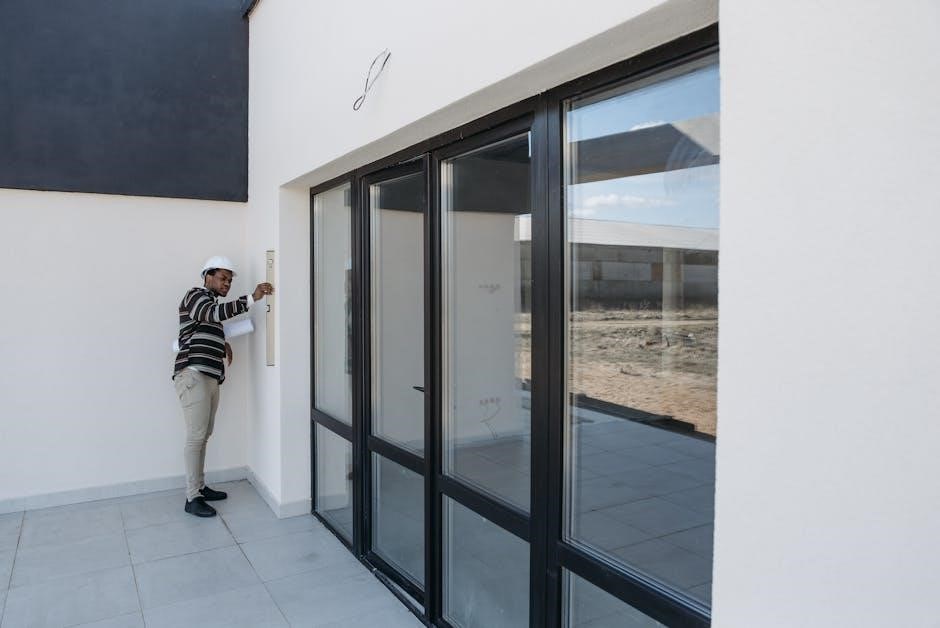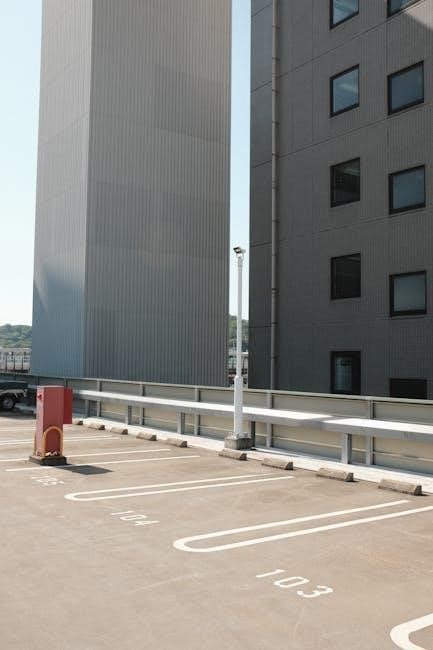The Building Safety Act 2022 is a landmark legislation passed in response to the Grenfell Tower tragedy, aiming to enhance safety standards in higher-risk buildings across England and Wales.
1.1 Background and Objectives
The Building Safety Act 2022 was enacted in response to the Grenfell Tower tragedy, addressing systemic flaws in building safety regulations. It aims to overhaul the UK’s building safety framework, ensuring safer homes and protecting residents. The Act aligns with Dame Judith Hackitt’s 2018 review, which called for radical reform. Its primary objectives include establishing a robust regulatory regime, enhancing accountability for building owners and contractors, and prioritizing resident safety. It also seeks to restore public confidence in the construction industry by introducing stricter standards and enforcement mechanisms, particularly for higher-risk buildings.
1.2 Key Provisions and Reforms
The Building Safety Act 2022 introduces significant reforms, including the establishment of a Building Safety Regulator to oversee safety in higher-risk buildings. It extends liability for building defects to 30 years, ensuring accountability for constructors and developers. The Act also introduces a new regulatory regime for higher-risk buildings, mandating stricter safety standards and compliance measures. Additionally, it strengthens resident protections and enhances enforcement powers, ensuring compliance with updated building regulations. These provisions aim to address historical gaps in building safety oversight, fostering a culture of accountability and safety across the construction industry.
1.3 Implementation Timeline

The Building Safety Act 2022 received Royal Assent on 28 April 2022, marking the beginning of its implementation. The Act’s provisions were rolled out in phases, with the transitional period closing on 6 April 2024. This timeline ensured a structured approach to compliance, allowing stakeholders to adapt to new regulations. Key measures, such as the new regulatory regime for higher-risk buildings, became fully operational post-transition. Additional reforms, including the Building Safety Levy, are set to commence in autumn 2026, further solidifying the Act’s long-term impact on the construction and property sectors.

Regulatory Framework and Governance
The Building Safety Act 2022 establishes a robust regulatory framework, introducing the Building Safety Regulator to oversee compliance and enforce safety standards, particularly for higher-risk buildings.
2.1 The Role of the Building Safety Regulator
The Building Safety Regulator, established under the Building Safety Act 2022, plays a pivotal role in enforcing safety standards across England and Wales. Its primary responsibilities include overseeing the safety of higher-risk buildings, ensuring compliance with new regulatory requirements, and managing the registration and certification processes for these structures. The regulator also holds the authority to investigate non-compliance issues and impose penalties, thereby ensuring accountability within the construction and property management sectors. This centralized oversight mechanism aims to foster a culture of safety and accountability, ultimately protecting residents and improving public trust in building safety systems.
2.2 New Regulatory Regime for Higher-Risk Buildings (HRBs)
The Building Safety Act 2022 introduces a stringent regulatory regime for Higher-Risk Buildings (HRBs), primarily targeting multi-occupancy residential buildings over 18 meters. This regime mandates enhanced safety measures, including stricter design and construction standards, as well as ongoing compliance requirements. The new framework requires HRBs to adhere to a more rigorous approval and certification process, overseen by the Building Safety Regulator. This includes regular inspections and the maintenance of safety documentation. The regime also imposes accountability on dutyholders, such as developers and building owners, ensuring they meet safety obligations throughout a building’s lifecycle. These measures aim to mitigate risks and safeguard occupants in high-risk structures.

2.3 Extended Liability Period for Building Defects
The Building Safety Act 2022 significantly extends the liability period for building defects from 6 to 30 years, ensuring accountability for developers and contractors over a longer timeframe. This change addresses concerns about substandard construction practices and provides greater protection for residents. The extended period allows more time for defects to be identified and addressed, particularly in complex structures. This reform emphasizes the importance of quality and durability in construction, aligning with the Act’s broader goals of enhancing safety and accountability. Contractors must now prioritize long-term building integrity to avoid future liabilities.

Protections for Residents and Leaseholders
The Building Safety Act 2022 introduces enhanced protections for residents and leaseholders, ensuring their rights are prioritized. It prohibits unfair costs for remedial works, safeguarding leaseholders from financial burdens. The Act strengthens legal safeguards, providing clearer pathways for redress and ensuring residents are central to decision-making processes. These measures aim to restore trust and security for those living in higher-risk buildings, reflecting a commitment to fair treatment and accountability. The reforms specifically target leaseholder protections, addressing historical injustices and promoting transparency in building safety matters. This section underscores the Act’s focus on resident well-being and financial security.
3.1 Enhanced Rights and Protections for Leaseholders
The Building Safety Act 2022 significantly strengthens the rights of leaseholders, ensuring they are protected from unfair financial burdens related to building safety issues. The Act introduces measures to prevent leaseholders from being charged for remedial works to address historical defects, unless they contributed to the issue. It also extends the liability period for defects to 30 years, providing leaseholders with more time to seek redress. These protections aim to restore trust and fairness, ensuring leaseholders are not unfairly penalized for safety failures beyond their control. The reforms emphasize accountability for developers and building owners, while safeguarding residents’ financial security and legal rights.
3.2 Provisions Against Unfair Costs for Remedial Works
The Building Safety Act 2022 includes provisions to protect residents from unfair costs associated with remedial works for historical building defects. Leaseholders are now shielded from being charged for repairs unless they directly contributed to the issue. The Act extends the liability period for defects to 30 years, ensuring accountability for developers and building owners. Additionally, the government has introduced measures such as the Building Safety Levy to help fund remedial works, reducing the financial burden on residents. These provisions aim to ensure fairness and transparency, preventing leaseholders from shouldering disproportionate costs for safety improvements they did not cause. This marks a significant shift in protecting homeowners’ rights.
3.3 The Building Safety (Leaseholder Protections) Regulations 2022
The Building Safety (Leaseholder Protections) Regulations 2022 were introduced to safeguard leaseholders from unfair financial burdens related to building safety issues. These regulations prohibit landlords from passing on costs for remedial works to leaseholders unless the leaseholder is directly responsible for the defects. They also restrict the use of indemnity clauses in lease agreements, ensuring leaseholders are not unfairly penalized. Additionally, the regulations reinforce the requirement for landlords to provide clear evidence of defects before seeking contributions from leaseholders. This measure aims to protect residents from financial exploitation while ensuring building safety standards are maintained effectively. These protections are a critical component of the broader reforms introduced by the Building Safety Act 2022.
Compliance and Enforcement Mechanisms
The Act establishes a robust enforcement framework, including the creation of the Building Safety Regulator, strict penalties for non-compliance, and expanded roles for local authorities to ensure adherence to safety standards.
4.1 New Duties for Building Owners and Contractors
The Building Safety Act 2022 introduces significant new duties for building owners and contractors, ensuring accountability throughout the construction and maintenance process. Building owners are now required to proactively manage safety risks, conduct regular audits, and maintain detailed records of safety measures. Contractors must adhere to stringent competency standards and demonstrate compliance with updated building regulations. The Act also mandates collaboration with the Building Safety Regulator, ensuring transparency and adherence to safety protocols. These duties reflect a shift toward a more proactive and accountable approach to building safety, aiming to prevent future tragedies and ensure the safety of occupants. The new framework emphasizes long-term responsibility for building defects and safety issues.
4.2 Penalties for Non-Compliance
The Building Safety Act 2022 imposes stringent penalties for non-compliance, ensuring adherence to new safety standards. Financial penalties for violations can be substantial, with criminal charges applicable in severe cases. Breaches of safety regulations may result in unlimited fines and imprisonment for individuals. The Act also introduces a retrospective approach, holding duty holders accountable for historical defects. These measures aim to enforce compliance with the new regulatory regime, deterring negligence and ensuring accountability across the industry. The penalties underscore the government’s commitment to upholding safety standards and protecting residents from unsafe building practices. Non-compliance is now a significant legal and financial risk for all parties involved.
4.3 Role of Local Authorities in Enforcement

Local authorities play a critical role in enforcing the Building Safety Act 2022, particularly in monitoring compliance with safety standards. They are empowered to conduct inspections, investigate breaches, and take enforcement action against non-compliant parties. Authorities work closely with the Building Safety Regulator to ensure that higher-risk buildings meet the required safety criteria. Additionally, local authorities are responsible for supporting residents by addressing concerns and providing guidance on safety-related matters. Their proactive approach ensures that safety standards are upheld, and accountability is maintained throughout the building lifecycle, fostering a safer living environment for occupants. Their role is pivotal in implementing the Act’s objectives effectively.
Industry Impact and Future Outlook
The Building Safety Act 2022 has significantly impacted the construction industry, increasing accountability for developers and contractors. Its focus on safety and compliance is reshaping industry practices.
5.1 Implications for Developers and Contractors
The Building Safety Act 2022 imposes stricter regulations on developers and contractors, requiring them to take greater responsibility for building safety and defect remediation; Contractors now face extended liability periods, up to 30 years, for safety defects. The Act mandates new competency requirements and compliance measures, ensuring that all parties involved in construction projects adhere to higher standards. These changes aim to shift the culture within the industry, prioritizing safety and accountability over cost-cutting practices. Developers must also provide financial protections for leaseholders and residents, reducing the burden of remedial works. This has led to increased costs and operational changes for firms.
5.2 Future Updates and Anticipated Changes
The Building Safety Act 2022 is expected to evolve with future updates, as secondary legislation and regulatory clarifications are implemented. The government has indicated plans to introduce a Building Safety Levy in autumn 2026, funded by developers, to support safety measures in new residential buildings. Additionally, further guidance on the new regulatory regime for higher-risk buildings is anticipated, potentially expanding compliance requirements. These updates aim to ensure the Act remains effective in addressing emerging risks and improving safety standards. Stakeholders should stay informed as the framework continues to develop, reflecting the UK’s commitment to robust building safety practices.
5.3 Long-Term Goals for Building Safety in the UK
The Building Safety Act 2022 sets a foundation for long-term improvements in building safety, aiming to create a safer built environment and prevent future tragedies. A key goal is to ensure accountability across the entire lifecycle of buildings, from design to occupation. The Act also seeks to foster a culture of safety within the construction industry, promoting higher standards and better practices. By addressing systemic issues and enhancing regulatory oversight, the UK aims to achieve sustained improvements in building safety, ensuring safer homes and communities for generations to come.
